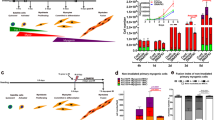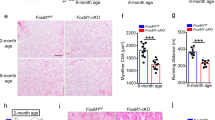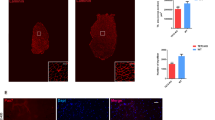Abstract
Cell-cycle checkpoints help to protect the genomes of proliferating cells under genotoxic stress. In multicellular organisms, cell proliferation is often directed toward differentiation during development and throughout adult homeostasis. To prevent the formation of differentiated cells with genetic instability, we hypothesized that genotoxic stress may trigger a differentiation checkpoint. Here we show that exposure to genotoxic agents causes a reversible inhibition of myogenic differentiation. Muscle-specific gene expression is suppressed by DNA-damaging agents if applied prior to differentiation induction but not after the differentiation program is established. The myogenic determination factor, MyoD (encoded by Myod1), is a target of the differentiation checkpoint in myoblasts. The inhibition of MyoD by DNA damage requires a functional c-Abl tyrosine kinase (encoded by Abl1), but occurs in cells deficient for p53 (transformation-related protein 53, encoded by Trp53) or c-Jun (encoded by the oncogene Jun). These results support the idea that genotoxic stress can regulate differentiation, and identify a new biological function for DNA damage–activated signaling network.
This is a preview of subscription content, access via your institution
Access options
Subscribe to this journal
Receive 12 print issues and online access
$209.00 per year
only $17.42 per issue
Buy this article
- Purchase on Springer Link
- Instant access to full article PDF
Prices may be subject to local taxes which are calculated during checkout






Similar content being viewed by others
References
Friedberg, E.C., Walker, G.C. & Siede, W. DNA Repair and Mutagenesis (AMS Press, Washington, D.C., 1995).
Weinert, T. DNA damage and checkpoint pathways: molecular anatomy and interactions with repair. Cell 94, 555–558 (1998).
Paulovich, A.G., Toczyski, D.P. & Hartwell, L.H. When checkpoints fail. Cell 88, 315–321 (1997).
Zhou, B.B. & Elledge, S.J. The DNA damage response: putting checkpoints in perspective. Nature 408, 433–439 (2000).
Walsh, K. & Perlman, H. Cell cycle exit upon myogenic differentiation. Curr. Opin. Genet. Dev. 7, 597–602 (1997).
Lassar, A. & Munsterberg, A. Wiring diagrams: regulatory circuits and the control of skeletal myogenesis. Curr. Opin. Cell Biol. 6, 432–442 (1994).
Wei, Q. & Paterson, B.M. Regulation of MyoD function in the dividing myoblast. FEBS Lett. 490, 171–178 (2001).
Puri, P.L. & Sartorelli, V. Regulation of muscle regulatory factors by DNA-binding, interacting proteins, and post-transcriptional modifications. J. Cell. Physiol. 185, 155–173 (2000).
Molkentin, J.D. & Olson, E.N. Combinatorial control of muscle development by basic helix–loop–helix and MADS-box transcription factors. Proc. Natl Acad. Sci. USA 93, 9366–9373 (1996).
Rudnicki, M.A. & Jaenisch, R. The MyoD family of transcription factors and skeletal myogenesis. Bioessays 17, 203–209 (1995).
Kurabayashi, M., Jeyaseelan, R. & Kedes, L. Doxorubicin represses the function of the myogenic helix–loop–helix transcription factor MyoD. Involvement of Id gene induction. J. Biol. Chem. 269, 6031–6039 (1994).
Puri, P.L. et al. Uncoupling of p21 induction and MyoD activation results in the failure of irreversible cell cycle arrest in doxorubicin-treated myocytes. J. Cell. Biochem. 66, 27–36 (1997).
Liu, Z.G. et al. Three distinct signalling responses by murine fibroblasts to genotoxic stress. Nature 384, 273–276 (1996).
Wang, J.Y.J. Cellular responses to DNA damage. Curr. Opin. Cell Biol. 10, 240–247 (1998).
Weintraub, H. et al. Activation of muscle-specific genes in pigment, nerve, fat, liver, and fibroblast cell lines by forced expression of MyoD. Proc. Natl Acad. Sci. USA 86, 5434–5438 (1989).
Wang, J.Y.J. Integrative signaling through c-Abl: a tyosine kinase with nuclear and cytoplasmic functions (Humana, Totowa, New Jersey, 2000).
Taagepera, S. et al. Nuclear-cytoplasmic shuttling of C-ABL tyrosine kinase. Proc. Natl Acad. Sci. USA 95, 7457–7462 (1998).
Wen, S.T., Jackson, P.K. & Van Etten, R.A. The cytostatic function of c-Abl is controlled by multiple nuclear localization signals and requires the p53 and Rb tumor suppressor gene products. EMBO J. 15, 1583–1595 (1996).
Songyang, Z. et al. Use of an oriented peptide library to determine the optimal substrates of protein kinases. Curr. Biol. 4, 973–982 (1994).
Sartorelli, V., Huang, J., Hamamori, Y. & Kedes, L. Molecular mechanisms of myogenic coactivation by p300: direct interaction with the activation domain of MyoD and with the MADS box of MEF2C. Mol. Cell. Biol. 17, 1010–1026 (1997).
Yuan, W., Condorelli, G., Caruso, M., Felsani, A. & Giordano, A. Human p300 protein is a coactivator for the transcription factor MyoD. J. Biol. Chem. 271, 9009–9013 (1996).
Eckner, R., Yao, T.P., Oldread, E. & Livingston, D.M. Interaction and functional collaboration of p300/CBP and bHLH proteins in muscle and B-cell differentiation. Genes Dev. 10, 2478–2490 (1996).
Puri, P.L. et al. p300 is required for MyoD-dependent cell cycle arrest and muscle-specific gene transcription. EMBO J. 16, 369–383 (1997).
Sartorelli, V. & Puri, P.L. The link between chromatin structure, protein acetylation and cellular differentiation. Front. Biosci. 6, D1024–D1047 (2001).
Baskaran, R., Dahmus, M.E. & Wang, J.Y. Tyrosine phosphorylation of mammalian RNA polymerase II carboxyl-terminal domain. Proc. Natl Acad. Sci. USA 90, 11167–11171 (1993).
Buchdunger, E. et al. Inhibition of the Abl protein-tyrosine kinase in vitro and in vivo by a 2-phenylaminopyrimidine derivative. Cancer Res. 56, 100–104 (1996).
Hartwell, L.H. & Weinert, T.A. Checkpoints: controls that ensure the order of cell cycle events. Science 246, 629–634 (1989).
Nouspikel, T. & Hanawalt, P.C. DNA repair in terminally differentiated cells. DNA Repair 1, 59–75 (2002).
Seale, P., Asakura, A. & Rudnicki, M.A. The potential of muscle stem cells. Dev. Cell 1, 333–342 (2001).
Blau, H.M., Brazelton, T.R. & Weimann, J.M. The evolving concept of a stem cell: entity or function? Cell 105, 829–841 (2001).
Alema, S. & Tato, F. Oncogenes and muscle differentiation: multiple mechanisms of interference. Semin. Cancer Biol. 5, 147–156 (1994).
Merlino, G. & Helman, L.J. Rhabdomyosarcoma—working out the pathways. Oncogene 18, 5340–5348 (1999).
Smith, L. et al. Duplication of ATR inhibits MyoD, induces aneuploidy and eliminates radiation-induced G1 arrest. Nature Genet. 19, 39–46 (1998).
Abraham, R.T. Cell cycle checkpoint signaling through the ATM and ATR kinases. Genes Dev. 15, 2177–2196 (2001).
Acknowledgements
We thank V. Sartorelli for discussion and for providing retroviral MyoD and MyoD (Tyr30Phe); M. Montminy, P.J. Woodring and M. Levrero for stimulating discussions; T. Hunter for critically reading the manuscript; L. Kedes and C. Poizat for providing adenoviral FLAG–MyoD; B. Paterson for providing His–MyoD; K. Du for providing polyclonal 293 cells stably transfected with Gal4–Luc; P. Stiegler for C2C12 cells with integrated luciferase reporters (Ckmm–Luc or Trp53–Luc); I.C. Hunton in the laboratory of J.Y.J.W. for the generation of MEFs and 3T3 cells; and J. Meisenhelder and U. Jhala for technical advice on phosphopeptide mapping. This work was supported by the American Cancer Society Postdoctoral Fellowship (L.D.W.), Human Frontiers Postdoctoral Fellowship (P.L.P.), Muscular Dystrophy Association (P.L.P.) and the US National Cancer Institute (J.Y.J.W.). P.L.P. is currently an Assistant Scientist of the Dulbecco Telethon Institute.
Author information
Authors and Affiliations
Corresponding authors
Ethics declarations
Competing interests
The authors declare no competing financial interests.
Supplementary information
Rights and permissions
About this article
Cite this article
Puri, P., Bhakta, K., Wood, L. et al. A myogenic differentiation checkpoint activated by genotoxic stress. Nat Genet 32, 585–593 (2002). https://doi.org/10.1038/ng1023
Received:
Accepted:
Published:
Issue Date:
DOI: https://doi.org/10.1038/ng1023
This article is cited by
-
DNA-PKcs regulates myogenesis in an Akt-dependent manner independent of induced DNA damage
Cell Death & Differentiation (2023)
-
The transcription factor NF-Y participates to stem cell fate decision and regeneration in adult skeletal muscle
Nature Communications (2021)
-
Current understanding of biological identity at the nanoscale and future prospects
Nature Nanotechnology (2021)
-
PDZRN3 protects against apoptosis in myoblasts by maintaining cyclin A2 expression
Scientific Reports (2020)
-
Mammalian endoreplication emerges to reveal a potential developmental timer
Cell Death & Differentiation (2018)



